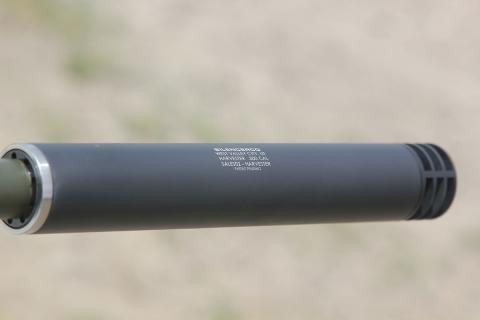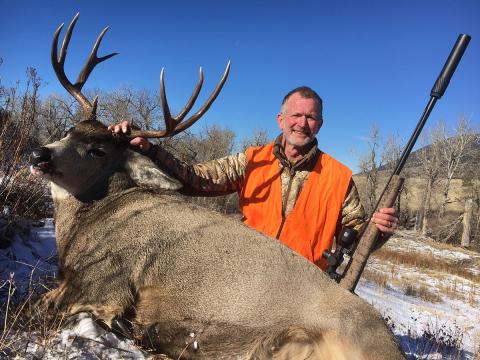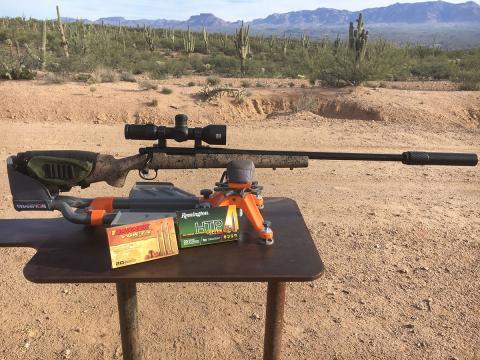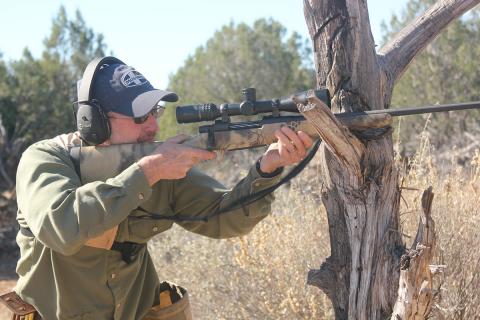Silence is Golden
The use of suppressors on hunting rifles is growing by leaps and bounds. Here’s why you should seriously consider their use.
Using the available terrain, South African professional hunter Andrew Renton and I carefully stalked closer to a large herd of blesbok that were feeding nonchalantly along. We topped a small rise on our bellies and slithered into position. I used my daypack as a rifle rest for Andrew’s 7mm Rem. Mag., put the crosshairs on the front shoulder of the largest ram and squeezed the trigger. He went down in a heap – and the herd kept on feeding as if nothing had happened.
That was more than a decade ago and was my first experience hunting with a suppressed rifle. The sound of the shot was so soft the remaining blesbok either didn’t hear it at all, or were not concerned if they did. And while I’m sure I also heard it, all I can remember is the rifle’s recoil.
That game is spooked much less when the gun goes off when using a suppressed rifle versus one not sporting a “can” is just one reason suppressor use is growing by leaps and bounds these days.
As you get older, you realize you can’t turn back the hands of time and do differently some of the crazy stuff you’ve done. In my case the list is long as your leg, and one of the things I wish I had done in my early years is take better care of my hearing. Today I’m pretty deaf, the result of being around too much loud stuff without wearing hearing protection. Guns going off, things blowing up, classic rock & roll, street cars with big motors and no mufflers, and much more have taken their toll. Today you don’t have the excuse we had, which was simply, we didn’t know better. You do. That’s why you should consider using a suppressor on your firearms if it’s legal for you to do so.
Are Suppressors Really Silencers?
Suppressors, also known as silencers, have been called the hearing protection of the 21st century sportsman. Also called “cans,” suppressors were invented by Hiram Percy Maxim in 1903, who also invented the automobile muffler. Despite common misconceptions, suppressors are not silent — they are simply mufflers for firearms, which function by trapping the expanding gasses at the muzzle and allowing them to slowly cool. More specifically, a suppressor uses a series of baffles that slows the release of these gases, which are what produces the loud noise when a firearm is triggered. How much the noise is lessened is a function of several things, including the size and type of suppressor, the cartridge, barrel length of the firearm and more.
Noise-induced hearing loss and tinnitus are two of the most common afflictions for recreational shooters and hunters. Suppressors reduce the noise of a gunshot by an average of 20-35 decibels (dB), which is roughly the same as earplugs or earmuffs. By decreasing the overall sound signature, suppressors help to preserve the hearing of shooters and hunters around the world.
According to Dr. William W. Clark, the current Director of the Washington University School of Medicine’s Program in Audiology and Communication Sciences, “the most serious threat to hearing comes from recreational hunting or target shooting.” This is in large part due to the fact that many hunters choose not to use traditional hearing protection devices like earplugs and earmuffs because they want to be able to hear their surroundings. Multiple studies have found that a high percentage of hunters never wear earplugs or earmuffs, and nearly half of all target shooters don’t consistently wear traditional hearing protection. Thus, it should come as no surprise that for every five years of hunting, hunters become seven percent more likely to experience high frequency hearing loss.
In a 2011 study, the Centers for Disease Control and Prevention, or CDC (https://www.cdc.gov/), stated, “the only potentially effective noise control method to reduce students’ or instructors’ noise exposure from gunfire is through the use of noise suppressors that can be attached to the end of the gun barrel.” In a similar study from 2014 on noise exposure at shooting ranges, the National Institute for Occupational Safety and Health, or NIOSH (https://www.cdc.gov/niosh/), recommended, “if feasible and legally permissible, attach noise suppressors to firearms to reduce peak sound pressure levels.” And in March, 2017, the National Hearing Conservation Association’s Task Force on Prevention of Noise-Induced Hearing Loss from Firearm Noise (https://www.researchgate.net/publication/320321145_Prevention_of_Noise-Induced_Hearing_Loss_from_Recreational_Firearms) stated that “using firearms equipped with suppressors” is one of “several strategies [that] can be employed to reduce the risk of acquiring NIHL and associated tinnitus from firearm noise exposure.”
According to the American Suppressor Association, (https://americansuppressorassociation.com/), as of 2018 the use of suppressors is legal in 42 states — the exceptions are Hawaii, California, Illinois, New York, New Jersey, Delaware, Rhode Island and Massachusetts — and in the 42 states where suppressors are legal, they are allowed for hunting in all but two (Connecticut and Vermont).
How Do You Buy A Suppressor?
In the United States suppressors are regulated by the Bureau of Alcohol, Tobacco, Firearms and Explosives (https://www.atf.gov/). To legally purchase or possess a suppressor you must be at least 21 years of age to purchase a suppressor from a dealer, be at least 18 years of age to purchase a suppressor from an individual on a Form 4 to Form 4 transfer (contingent on state laws), or be at least 18 years of age to possess a suppressor as a beneficiary of a trust or as a member of a corporation (contingent on state laws). You must also be a resident of the United States who is legally eligible to purchase a firearm, pass a BATFE background check with a typical process time of 8 to 10 months, pay a one-time $200 Transfer Tax and reside in one of the 42 states that currently allows civilian ownership of suppressors.
Why the $200 tax? Ever see the old TV show or the movie, “The Untouchables,” where during the 1920s and 1930s the Feds were constantly battling evil gangsters like Al Capone? On June 26, 1934, the federal government — which often found itself outgunned by the gangsters — passed the National Firearms Act, which “provided for the taxation of manufacturers, importers, and dealers in certain firearms and machine guns, taxed the sale or other disposal of such weapons, and restricted importation and regulate interstate transportation thereof.” Part of the Act was placing a $200 “Sin Tax” on silencers (that’s about $3,600 in today’s dollars) that would effectively ban their purchase by the majority of Americans. That $200 tax still stands today.
Are They Hard To Use?
Suppressors are really easy to use. “Direct thread” is one common method of suppressor attachment. This requires the muzzle of your firearm’s barrel to be threaded, which can be easily done by a gunsmith, although many new rifle models today come with a threaded barrel, the threads being covered by a screw-on end cap when a suppressor is not attached. The suppressor then simply screws onto the barrel. There are many thread types, but the most common are 1/2×28 for most .22 calibers, 9mm handguns and AR-15s, and 5/8×24 for rifles of .308 and similar size. Another attachment method is quick attachment, in which a brand-specific adaptor must be threaded to your firearm’s barrel, and a corresponding female adaptor threaded to the suppressor. Then the suppressor can be affixed to the firearm with a partial twist that takes less than a second.
A common question is, will a suppressor affect accuracy? The answer is, “maybe.” Attaching anything to a rifle barrel can change its harmonics and, thus, its accuracy, both in terms of group size and point of impact. So you have to spend some range time to get it dialed in. In my admittedly limited experience with suppressors, accuracy has usually improved. And a suppressor helps reduce recoil, which always helps your shooting.
A few years ago I was invited to a long-range shooting class sponsored in part by West Valley, UT-based SilencerCo (www.silencerco.com), a suppressor manufacturer peopled by folks with lots of experience in suppressor use and shooting as well as hunting. We rang gongs out to 900 meters on a regular basis using both bolt-action and AR-style rifles with suppressors attached. The SilencerCo folks told us both accuracy and our ability to put the bullet where we wanted would be enhanced with suppressed rifles – and they were right.
In The Field
On a November, 2018 elk and mule deer hunt in the Madison River Valley of Montana just south of Bozeman, Jumping Horse Ranch (www.jumpinghorseranch.com) manager and outfitter Jeff Klein and John Way, a long-time Montana hunting and fishing guide and current president of the Montana Outfitters Association, squired me around as I carried a suppressed Remington Gen 2 rifle (https://www.remington.com/rifles/bolt-action/model-700/model-700-5-r-stainless-threaded-gen-2) chambered in .300 Win. Mag. and loaded with Barnes VOR-TX ammunition featuring the 180-grain Barnes tipped TSX bullet (www.barnesbullets.com/ammunition/vor-tx-rifle.) This combination produced 3-shot, 100-yard groups measuring right at one-half inch. Recoil was negligible, and when the time came, I made one-shot kills on both animals at moderate distances. The amazing thing, though, was the fact that, just as was the case with the South African blesbok so many years ago, at the shot none of the adjacent animals showed any undue excitement when the rifle went bang.
One practical observation. Suppressors are long and relatively heavy. For example, SilencerCo’s Omega 300, designed for calibers from 5.77mm to .300 Win. Mag., is 7.09-inches long, 1.56-inches in diameter, and weighs 14 oz. This can make an already long barrel even longer and more difficult to maneuver afield. The Remington Gen 2 I carried comes with a 24-inch barrel, and after my Montana hunt I’m thinking a barrel no longer than 22 inches makes more sense when adding a suppressor.
The Future
Introduced in the U.S. House of Representatives on January 9, 2017, the Hearing Protection Act of 2017 (H.R. 367) would amend the Internal Revenue Code to both eliminate the $200 transfer tax on firearm silencers, and treat any person who acquires or possesses a firearm silencer as meeting any registration or licensing requirements of the National Firearms Act with respect to said silencer. Also, any person who pays a transfer tax on a silencer after October 22, 2015, may receive a refund of such tax. The bill also amends the federal criminal code to preempt state or local laws that tax or regulate firearm silencers. It would also greatly shorten the time a person has to wait before acquiring a suppressor.
If the bill were to pass, it will be much simpler and quicker for the general public to purchase and use suppressors. Regardless, suppressor use for both recreational shooting and hunting is here to stay. If you value your hearing — and you should — you owe it to yourself to check them out.–Bob Robb





